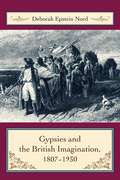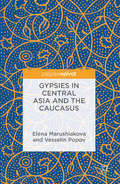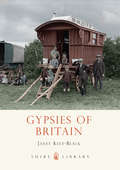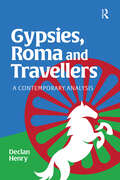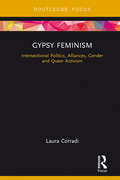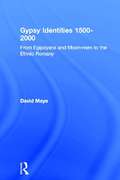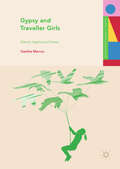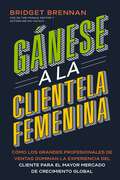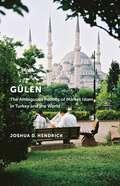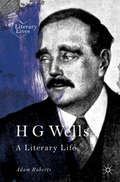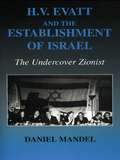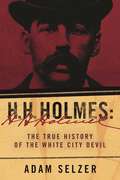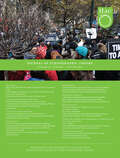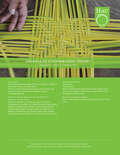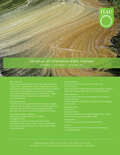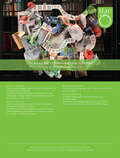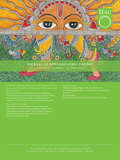- Table View
- List View
Gypsies and the British Imagination, 1807-1930
by Deborah NordGypsies and the British Imagination, 1807-1930, is the first book to explore fully the British obsession with Gypsies throughout the nineteenth century and into the twentieth. Deborah Epstein Nord traces various representations of Gypsies in the works of such well-known British authors John Clare, Walter Scott, William Wordsworth, George Eliot, Arthur Conan Doyle, and D. H. Lawrence. Nord also exhumes lesser-known literary, ethnographic, and historical texts, exploring the fascinating histories of nomadic writer George Borrow, the Gypsy Lore Society, Dora Yates, and other rarely examined figures and institutions.Gypsies were both idealized and reviled by Victorian and early-twentieth-century Britons. Associated with primitive desires, lawlessness, cunning, and sexual excess, Gypsies were also objects of antiquarian, literary, and anthropological interest. As Nord demonstrates, British writers and artists drew on Gypsy characters and plots to redefine and reconstruct cultural and racial difference, national and personal identity, and the individual's relationship to social and sexual orthodoxies. Gypsies were long associated with pastoral conventions and, in the nineteenth century, came to stand in for the ancient British past. Using myths of switched babies, Gypsy kidnappings, and the Gypsies' murky origins, authors projected onto Gypsies their own desires to escape convention and their anxieties about the ambiguities of identity. The literary representations that Nord examines have their roots in the interplay between the notion of Gypsies as a separate, often despised race and the psychic or aesthetic desire to dissolve the boundary between English and Gypsy worlds. By the beginning of the twentieth century, she argues, romantic identification with Gypsies had hardened into caricature-a phenomenon reflected in D. H. Lawrence's The Virgin and the Gipsy-and thoroughly obscured the reality of Gypsy life and history.
Gypsies in Central Asia and the Caucasus
by Elena Marushiakova Vesselin PopovThis book explores diverse communities living in Central Asia and the Caucasus, who are generally gathered under the umbrella term of ‘Gypsies’, their multidimensional identities, self-appellations and labels given to them by surrounding populations, researcher and policy-makers. The book presents various Gypsy and Gypsy-like communities and provides a comprehensive review of their history, demography, ways of life, past and present occupations, and contemporary migration in post-Soviet space. The authors situate these communities in historical settings and also in the wider context of contemporary evolving global and areal developments.The book will be of interest to scholars and students of history, sociology, social anthropology, nationalities studies, global and Central Asia and Caucasus areal studies, and Gypsy/Romani studies, and also for policy-makers and civic organizations.
Gypsies in Madrid: Sex, Gender and the Performance of Identity (Mediterranea #2)
by Paloma Gay y BlascoThroughout the twentieth century, Spanish people have deployed conflicting sexual moralities in their struggle for political supremacy within the state. The Spanish Gypsies or Gitanos, who live at the very bottom of the Spanish socio-economic scale, have appropriated this concern with gender morality and, in the process, have reinvented themselves as the only honourable Spaniards. Although the Gitano gender ideology has a distinctively Spanish flavour, it revolves around a conceptualization of the female body that is radically different from that of other Spaniards. The subtle exploration of these acts of cultural invention is one of the original features of this important new ethnography. Another even more striking aspect of the work is the author's vision of the 'impermanent' nature of the Gitano social order and the absence of any representation of 'community' or 'society'. Unlike their non-Gypsy neighbours, Gitanos do not use concepts of tradition, territory or social harmony as bases for their singularity. Instead, they focus on the evaluation of personal moral performances in the present. In a cultural universe where all activities are markers of shared identity, and where personhood is always sexed, men and women continually enact the superiority of Gypsies over non-Gypsies. Through dress, manner and the management of emations, or at wedding rituals where the virginity of young brides is put to the test, the body works as the site of these processes.
Gypsies of Britain
by Janet Keet-BlackThis title tells the story of the Romany Gypsies in Britain. Where they came from, how they arrived. It explores their travelling way of life and their traditional occupations, including harvesting, making baskets, dealing in horses, fortune telling and rat catching to royalty. Their impact on traditional museum dancing. It reveals their service as preachers and soldiers and their continuing contribution to life in Britain today.TOC: I: Origins /II: Lifestyle /III: Occupations /IV: Preachers and soldiers /V: Britain's Gypsies Today
Gypsies, Roma and Travellers: A Contemporary Analysis
by Declan HenryEssential reading for those who want to develop greater knowledge and awareness of the history, culture and lifestyles of GRT people.There are many misconceptions about the Gypsy, Roma and Traveller communities in the UK and Ireland. Little is understood of their culture and they are often marginalised by society. This book dispels many of the myths and gives a compassionate and empathetic view of the daily struggles they face including discrimination, racism and poverty. It also reviews criticisms directed at them and determines whether these are justified. Services are analysed to establish what works and what is weak. Packed with expert opinions from professionals working in the field and case studies and vignettes, garnered from personal interviews by the author with GRT people. Drawing from a wide range of perspectives from both inside and outside the respective communities, this book provides readers with all the key elements required to gain a deeper knowledge and understanding of these remarkable communities and their cultures.
Gypsy Bride: One girl's true story of falling in love with a gypsy boy
by Sam Skye Lee'I felt like Cinderella, Sleeping Beauty, Snow White and all the other fairy-tale princesses, and Pat was my Prince Charming.'Sam Skye Lee had often thought about getting married, but never imagined that her dress would be bright pink with flashing lights and weigh a staggering 20-stone. But then she didn't count on having a gypsy wedding...It's rare for a 'gorger', or non-traveller, to marry into the gypsy community. But after a shocking childhood tragedy, Sam found the comfort she needed from an unxpected source - Patrick and his family of travellers.Gypsy Bride is the heartwarming true story of how an ordinary girl finds herself discovering an extraordinary world. A place where 'grabbing' is a sign a boy fancies you, six-year-olds get spray tans, and christenings, weddings and funerals are jaw-droppingly flamboyant.This love story is more than boy meets girl. It's about a girl who falls in love with a whole race of people and their wonderful ways.
Gypsy Empire
by Eamon DillonIrish Travellers have never enjoyed a higher profile, at home and abroad, for good reasons and bad. On the one hand are the positive stories like the success of boxers such as John Joe Nevin and Tyson Fury, the popularity of Big Fat Gypsy Wedding and Paddy Doherty’s victory on Celebrity Big Brother. On the other are controversial news stories such as the Dale Farm stand-off and the recent convictions for slavery. Gypsy Empire delves into the heart of Traveller life, focusing on three aspects that have coloured perceptions of Travellers among the wider community: family feuds, bare-knuckle fights and trading. Many Irish Travellers are driven by the need to prove their status among their own, a powerful instinct epitomised by those who engage in brutal bare-knuckle fights. These bouts are fuelled by family feuds which sometimes erupt in vicious acts of violence. We meet many colourful characters, among them some of the world’s most prolific and gifted criminals, their self-reliance providing an edge over other crime gangs.This is a golden era for the Traveller clans which are expanding and growing like never before. Gypsy Empire takes the reader inside the hidden world of Irish Travellers.
Gypsy Feminism: Intersectional Politics, Alliances, Gender and Queer Activism (Routledge Advances in Sociology)
by Laura CorradiClumsy stereotypes of the Romani and Travellers communities abound, not only culturally in programmes such as Big Fat Gypsy Weddings, but also amongst educators, social workers, administrators and the medical profession. Gypsy cultures are invariably presented as ruled by tradition and machismo. Women are presented as helpless victims, especially when it comes to gendered forms of violence. The reality, however, is much more complicated. In Gypsy Feminism, Laura Corradi demonstrates how Romaphobia – racist and anti-Gypsy rhetoric and prejudice, pervading every level of society – has led to a situation where Romani communities face multiple discrimination. In this context, the empowerment of women and girls becomes still more difficult: until recently, for example, women have largely remained silent about domestic violence in order to protect their communities, which are already under attack. Examining feminist research and action within Romani communities, Corradi demonstrates the importance of an intersectional approach in order to make visible the combination of racism and sexism that Gypsy women face every day. This concise and authoritative book will appeal to scholars and students in the areas of Sociology, Cultural Studies, Women’s and Gender Studies and Anthropology, as well as Politics, Media Studies, Social Policy, and Social Work. It is also an invaluable resource for activists, community and social service workers, and policymakers.
Gypsy Identities 1500-2000: From Egipcyans and Moon-men to the Ethnic Romany
by David MayallGypsies have lived in England since the early sixteenth century, yet considerable confusion and disagreement remain over the precise identity of the group. The question 'Who are the Gypsies?' is still asked and the debates about the positioning and permanence of the boundary between Gypsy and non-Gypsy are contested as fiercely today as at any time before.This study locates these debates in their historical perspective, tracing the origins and reproduction of the various ways of defining and representing the Gypsy from the early sixteenth century to the present day. Starting with a consideration of the early modern description of Gypsies as Egyptians, land pirates and vagabonds, the volume goes on to examine the racial classification of the nineteenth century and the emergence of the ethnic Gypsy in the twentieth century. The book closes with an exploration of the long-lasting image of the group as vagrant and parasitic nuisances which spans the whole period from 1500 to 2000.
Gypsy Politics and Social Change: The Development of Ethnic Ideology and Pressure Politics among British Gypsies from Victorian Reformism to Romany Nationalism (Routledge Revivals)
by Thomas ActonThis book, first published in 1974, analyses the position of the Gypsies in Britain in the twentieth century, and assesses its significance in their overall history. Two dramatic shifts in Government policy towards the Gypsies are examined – in the 1880s and the 1960s – as are the changes in the stereotype of the ‘true Gypsy’. Dr Acton traces the developments of attitudes and economic conditions that gave rise to the 1970s increase in interest in Gypsies, and discusses the concomitant political and pressure group activity. He gives an account of the historical background to modern Gypsy politics; describes the postwar situation of the Gypsies in England and Wales, including pro-Gypsy pressure group activity up to 1965, and goes on to cover the campaigns of the Gypsy Council, including a sociological assessment of its work. He considers these aspects of Gypsy life in the light of modern sociological theory on minorities and race relations.
Gypsy Politics and Social Change: The Development of Ethnic Ideology and Pressure Politics among British Gypsies from Victorian Reformism to Romany Nationalism (Routledge Revivals)
by Thomas ActonThis book, first published in 1974, analyses the position of the Gypsies in Britain in the twentieth century, and assesses its significance in their overall history. Two dramatic shifts in Government policy towards the Gypsies are examined – in the 1880s and the 1960s – as are the changes in the stereotype of the ‘true Gypsy’. Dr Acton traces the developments of attitudes and economic conditions that gave rise to the 1970s increase in interest in Gypsies, and discusses the concomitant political and pressure group activity. He gives an account of the historical background to modern Gypsy politics; describes the postwar situation of the Gypsies in England and Wales, including pro-Gypsy pressure group activity up to 1965, and goes on to cover the campaigns of the Gypsy Council, including a sociological assessment of its work. He considers these aspects of Gypsy life in the light of modern sociological theory on minorities and race relations.
Gypsy and Traveller Ethnicity: The Social Generation of an Ethnic Phenomenon
by Brian A BeltonThe book explores the notion of Gypsy and Traveller ethnicity and provides a critique of the conceptual basis of racial and ethnic categorisation. An analysis of the post-war housing situation is given in order to illustrate a connection between social and economic conditions, legislation affecting gypsies and travellers and the visibility and general consciousness of the gypsy and traveller population. The originality of the book lies in its argument that the position of gypsies and travellers largely arises out of social conditions and interaction rather than political, biological or ideological determinants. It puts forward the notion of an ethnic narrative of traveller identity and illustrates how variations of this have been defensively deployed by some travellers and elaborated on by theorists. Belton focuses on the social generation of travellers as a cultural, ethnic and racial categorization, offering a rational explanation of the development of an itinerant population that is less ambiguous and more informative in terms of the social nature of the gypsy and traveller position than interpretations based on 'blood', 'breed', 'stock', ethnicity or race that dominate the literature.
Gypsy and Traveller Girls: Silence, Agency and Power (Studies in Childhood and Youth)
by Geetha MarcusThis book presents the untold stories of Gypsy and Traveller girls living in Scotland. Drawing on accounts of the girls’ lives and offering space for their voices to be heard, the author addresses contemporary and traditional stereotypes and racialised misconceptions of Gypsies and Travellers. Marcus explores how the stubborn persistence of these negative views appears to contribute to policies and practices of neglect, inertia or intervention that often aim to ‘civilise’ and further assimilate these communities into the mainstream settled population. It is against this backdrop that the book exposes the girls’ racialised and gendered experiences, which impact on their struggles as young people to realise their potential and future prospects. Their narratives reveal the strengths of a distinct community, and the complexity of their silence and agency within the patriarchal structures that pervade the private spaces of home and the public spaces of education. This study also invites the reader to reflect on how the experiences of Gypsy and Traveller girls compares with young women from other social backgrounds, and questions if there is more that binds us than divides us as women in the modern world. Gypsy and Traveller Girls will be of interest to students and scholars across a range of disciplines, including sociology, education, gender studies and social policy.
Gánese a la clientela femenina: Cómo transformar la experiencia del cliente para los consumidores más poderosos del mundo
by Bridget BrennanLa primera pregunta que le hacen los vendedores a Bridget Brennan, CEO de Female Factor, es siempre la misma: «¿Cómo puedo sobrevivir cuando los clientes tienen tantas opciones respecto de dónde comprar mi producto?». Si bien hay muchas estrategias para crecer en ventas, la que ella visualiza es la que muchos vendedores pasar por alto, o sea, la más obvia: hacer que la experiencia del cliente sea tan grande que quieran invertir su tiempo y dinero con usted. Dado que las mujeres manejan entre el 70% y el 80% del presupuesto de consumo familiar y le otorgan un valor tan alto a la experiencia del servicio, esto parece no tener demasiada ciencia. ¿Sentido común? Sí. ¿Práctica común? No. En esta era tecnológica que se acelera vertiginosamente, hay una necesidad urgente de un nuevo modelo de ventas dirigido a la consumidora que empuña hábilmente su smartphone, instruida en Google, amante de las marcas, y que a menudo conoce más sobre los productos que desea adquirir que el mismo vendedor que se para frente a ella. En este nuevo libro, Brennan brinda a los profesionales de ventas una guía para dominar las habilidades necesarias para la comercialización en el siglo XXI.
Gülen: The Ambiguous Politics of Market Islam in Turkey and the World
by Joshua D. HendrickThe "Hizmet" ("Service")Movement of Fethullah Gülen is Turkey’s most influential Islamic identitycommunity. Widely praised throughout the early 2000s as a mild and moderatevariation on Islamic political identity, the Gülen Movement has long been atopic of both adulation and conspiracy in Turkey. In Gülen, Joshua D. Hendrick suggests that the Gülen Movement shouldbe given credit for playing a significant role in Turkey's rise to globalprominence.Hendrick draws on 14 months of ethnographic fieldworkin Turkey and the U.S. for his study. He argues that the movement’s growth andimpact both inside and outside Turkey position both its leader and itsfollowers as indicative of a "post political" turn in twenty-firstcentury Islamic political identity in general, and as illustrative of Turkey’spolitical, economic, and cultural transformation in particular.
H G Wells: A Literary Life (Literary Lives)
by Adam RobertsThis is the first new complete literary biography of H G Wells for thirty years, and the first to encompass his entire career as a writer, from the science fiction of the 1890s through his fiction and non-fiction writing all the way up to his last publication in 1946. Adam Roberts provides a comprehensive reassessment of Wells’ importance as a novelist, short-story writer, a theorist of social prophecy and utopia, journalist and commentator, offering a nuanced portrait of the man who coined the phrases ‘atom bomb’, ‘League of Nations’ ‘the war to end war’ and ‘time machine’, who wrote the world’s first comprehensive global history and invented the idea of the tank. In these twenty-six chapters, Roberts covers the entirety of Wells’ life and discusses every book and short story he produced, delivering a complete vision of this enduring figure.
H V Evatt and the Establishment of Israel: The Undercover Zionist (Israeli History, Politics and Society #Vol. 36)
by Daniel MandelThe Minister for External Affairs, and the dominant force in the formation of Australian foreign policy for a crucial decade in the battle over Palestine (1941-1949), Herbert Vere Evatt played a central role in the Australian political response to Zionism and the conflict in Palestine. This book, which uses a variety of primary sources from Australia, Israel, the United Kingdom and the United States, provides a valuable study of Evatt the Zionist, as well as illuminating a fascinating political figure. This valuable book charts the debate in Australia over the creation of a Jewish state as well as providing a genuinely entertaining study of Evatt himself.
H. H. Holmes: The True History of the White City Devil
by Adam SelzerAmerica's first and most notorious serial killer and his diabolical killing spree during the 1893 World's Fair in Chicago, now updated with a new afterword discussing Holmes' exhumation on American Ripper.H. H. Holmes: The True History of the White City Devil is the first truly comprehensive book examining the life and career of a murderer who has become one of America’s great supervillains. It reveals not only the true story but how the legend evolved, taking advantage of hundreds of primary sources that have never been examined before, including legal documents, letters, articles, and records that have been buried in archives for more than a century. Though Holmes has become just as famous now as he was in 1895, a deep analysis of contemporary materials makes very clear how much of the story as we know came from reporters who were nowhere near the action, a dangerously unqualified new police chief, and, not least, lies invented by Holmes himself. Selzer has unearthed tons of stunning new data about Holmes, weaving together turn-of-the-century America, the killer’s background, and the wild cast of characters who circulated in and about the famous “castle” building. This book will be the first truly accurate account of what really happened in Holmes’s castle of horror, and now includes an afterword detailing the author's participation in Holmes' exhumation on the TV series, American Ripper. Exhaustively researched and painstakingly brought to life, H. H. Holmes will be an invaluable companion to the upcoming Martin Scorsese and Leonardo DiCaprio movie about Holmes’s murder spree based on Erik Larson’s The Devil in the White City.
H. H. Holmes: The True History of the White City Devil
by Adam SelzerShares with readers America’s first and most infamous serial killer and his diabolical killing spree during the 1893 World’s Fair in ChicagoThe first comprehensive book following the life and career of H. H. HolmesA fascinating true story about a dark moment in Chicago’s historyH. H. Holmes: The True History of the White City Devil uncovers not only the true story of Holmes but also how the legend evolved. It uses hundreds of primary sources that have never been studied before. This includes letters, articles, legal documents, and records that have been tucked away in archives for more than 100 years. While H. H. Holmes is now as famous as he was in 1895, a thorough analysis of modern materials clarifies how much of the story as we know it came from reports who were far from the action, an incredibly unqualified new police chief, and lies from Holmes himself. This book is a tale of an outlaw. It covers Holmes’s own story with new insights. The author, Adam Selzer, has uncovered stunning new data about Holmes. He combines turn-of-the-century America, the crazy group of characters who were in and around the famous “castle” building, and the killer’s own background. This book is the first fully accurate account of what truly happened in Holmes’s horror castle. H. H. Holmes, with its exhaustive research and careful detail, is an irreplaceable partner to the upcoming Leonardo DiCaprio and Martin Scorsese movie about Holmes’s murder spree based on Erik Larson’s The Devil in the White City.
HAU vol 10 num 2
by The University of Chicago PressThis is volume 10 issue 2 of HAU: Journal of Ethnographic Theory. HAU: Journal of Ethnographic Theory, is an international journal which aims to situate ethnography as the prime heuristic of anthropology, and return it to the forefront of conceptual developments in the discipline. The journal is motivated by the need to reinstate ethnographic theorization in contemporary anthropology as a potent alternative to its "explanation" or "contextualization" by philosophical arguments, moves which have resulted in a loss of the discipline's distinctive theoretical nerve. By drawing out its potential to critically engage and challenge Western cosmological assumptions and conceptual determinations, HAU aims to provide an exciting new arena for evaluating ethnography as a daring enterprise for 'worlding' alien terms and forms of life, by exploiting their potential for rethinking humanity and alterity.
HAU vol 9 num 1
by The University of Chicago PressThis is volume 9 issue 1 of HAU: Journal of Ethnographic Theory. HAU: Journal of Ethnographic Theory, is an international journal which aims to situate ethnography as the prime heuristic of anthropology, and return it to the forefront of conceptual developments in the discipline. The journal is motivated by the need to reinstate ethnographic theorization in contemporary anthropology as a potent alternative to its "explanation" or "contextualization" by philosophical arguments, moves which have resulted in a loss of the discipline's distinctive theoretical nerve. By drawing out its potential to critically engage and challenge Western cosmological assumptions and conceptual determinations, HAU aims to provide an exciting new arena for evaluating ethnography as a daring enterprise for 'worlding' alien terms and forms of life, by exploiting their potential for rethinking humanity and alterity.
HAU: Journal of Ethnographic Theory, volume 11 number 2 (Autumn 2021)
by HAU: Journal of Ethnographic TheoryThis is volume 11 issue 2 of HAU: Journal of Ethnographic Theory. HAU: Journal of Ethnographic Theory, is an international journal which aims to situate ethnography as the prime heuristic of anthropology, and return it to the forefront of conceptual developments in the discipline. The journal is motivated by the need to reinstate ethnographic theorization in contemporary anthropology as a potent alternative to its "explanation" or "contextualization" by philosophical arguments, moves which have resulted in a loss of the discipline's distinctive theoretical nerve. By drawing out its potential to critically engage and challenge Western cosmological assumptions and conceptual determinations, HAU aims to provide an exciting new arena for evaluating ethnography as a daring enterprise for 'worlding' alien terms and forms of life, by exploiting their potential for rethinking humanity and alterity.
HAU: Journal of Ethnographic Theory, volume 11 number 3 (Winter 2021)
by HAU: Journal of Ethnographic TheoryThis is volume 11 issue 3 of HAU: Journal of Ethnographic Theory. HAU: Journal of Ethnographic Theory, is an international journal which aims to situate ethnography as the prime heuristic of anthropology, and return it to the forefront of conceptual developments in the discipline. The journal is motivated by the need to reinstate ethnographic theorization in contemporary anthropology as a potent alternative to its "explanation" or "contextualization" by philosophical arguments, moves which have resulted in a loss of the discipline's distinctive theoretical nerve. By drawing out its potential to critically engage and challenge Western cosmological assumptions and conceptual determinations, HAU aims to provide an exciting new arena for evaluating ethnography as a daring enterprise for 'worlding' alien terms and forms of life, by exploiting their potential for rethinking humanity and alterity.
HAU: Journal of Ethnographic Theory, volume 12 number 1 (Spring 2022)
by HAU: Journal of Ethnographic TheoryThis is volume 12 issue 1 of HAU: Journal of Ethnographic Theory. HAU: Journal of Ethnographic Theory, is an international journal which aims to situate ethnography as the prime heuristic of anthropology, and return it to the forefront of conceptual developments in the discipline. The journal is motivated by the need to reinstate ethnographic theorization in contemporary anthropology as a potent alternative to its "explanation" or "contextualization" by philosophical arguments, moves which have resulted in a loss of the discipline's distinctive theoretical nerve. By drawing out its potential to critically engage and challenge Western cosmological assumptions and conceptual determinations, HAU aims to provide an exciting new arena for evaluating ethnography as a daring enterprise for 'worlding' alien terms and forms of life, by exploiting their potential for rethinking humanity and alterity.
HAU: Journal of Ethnographic Theory, volume 12 number 2 (Autumn 2022)
by HAU: Journal of Ethnographic TheoryThis is volume 12 issue 2 of HAU: Journal of Ethnographic Theory. HAU: Journal of Ethnographic Theory, is an international journal which aims to situate ethnography as the prime heuristic of anthropology, and return it to the forefront of conceptual developments in the discipline. The journal is motivated by the need to reinstate ethnographic theorization in contemporary anthropology as a potent alternative to its "explanation" or "contextualization" by philosophical arguments, moves which have resulted in a loss of the discipline's distinctive theoretical nerve. By drawing out its potential to critically engage and challenge Western cosmological assumptions and conceptual determinations, HAU aims to provide an exciting new arena for evaluating ethnography as a daring enterprise for 'worlding' alien terms and forms of life, by exploiting their potential for rethinking humanity and alterity.
